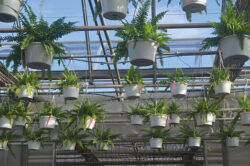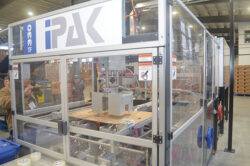
Features
State of the sector
Opportunities and challenges coming in 2023.
December 30, 2022 By Andrew Snook
 Greenhouse growers across the country note inflation, labour shortages and energy as key challenges to overcome in 2023.
Greenhouse growers across the country note inflation, labour shortages and energy as key challenges to overcome in 2023. Labour. Energy. Inflation. Supply chains.
These are among the top concerns from growers across the country for the coming year. To learn about the challenges and opportunities for 2023, Greenhouse Canada reached out to growers and associations across the country. Here is what they had to say.
Ontario
In Ontario, where the majority of greenhouse operations are located, one of the biggest challenges for fruit and vegetable growers is achieving higher returns to offset increased costs due to rising energy costs and inflation, explains Jan Vander Hout, co-owner of Beverly Greenhouses and board member for the Ontario Greenhouse Vegetable Growers, Ontario Fruit and Vegetable Growers Association, The Ontario Greenhouse Alliance, and the Fruit and Vegetable Growers of Canada.
“It’s a big challenge because at the same time people are having a hard time paying for their groceries because of all the other increased costs in their lives. That economic piece is the biggest challenge right now – as an industry for sure, and as a society,” Vander Hout says. “Everyone who pays the grocery bill or restaurant bill understands this is expensive now, and our costs have not been fully realized through the system yet. We actually need more than we’re getting right now, or their will be casualties.”
Joe Sbrocchi, general manager for the Ontario Greenhouse Vegetable Growers, is an agreement, stating that inflation is by far the biggest challenge for Ontario’s growers.
“Inflation has really ravaged our sector this year. The ability to translate so many of those input costs – because, quite frankly, it’s every single one of them – into pricing for the retailers and foodservice companies has not gone successfully, and it needs to be this [coming] year.”
Energy is another major concern for Ontario’s greenhouse sector.
“Ontario needs to reinforce its infrastructure. Farms that want to expand are hit with barriers to available electricity,” Vander Hout says, adding that as society continues to electrify various aspects of our lives, there’s still a lot of work that needs to be done for ensuring the country has the necessary capacity to accommodate energy demands. “It all takes electricity, and if you’re going to displace natural gas, you’re going to need a lot of infrastructure for that – distribution, transmission lines and generation.”
The ability to attract labour of varying skill levels is another challenge for the coming year.
“Everybody thinks in terms of a migrant workforce. Actually, it’s at every level, it’s no different than anywhere else,” Sbrocchi says, adding that data analytics is a key area of greenhouse operations that always needs talented people. “That’s one of the most important, if not the most important, because that’s about analysis that enables you to predict what’s going on.”
In the ornamental horticulture sector, Andrew Morse, executive director for Flowers Canada (Ontario) Inc. and Flowers Canada Growers Inc., says there are both opportunities and headwinds facing its members.
“I think most of our members are coming off two, or even three, of the best years they’ve ever had. And everyone’s kind of wondering how next year is going to shape up with the potential of a recession, as well as recovery from COVID-19. So, it’s anyone’s guess, frankly, but if I’m looking into the crystal ball, a lot of firms are likely trying to make an assessment as to where they see the market going and trying to react to that,” Morse says.
On the positive side, Morse sees increased opportunities for members due to the return of live events.
“Given that our sector has traditional events. They’ll do well in a recession, or better than many other sectors,” he says. “And part of that, I think, comes back to why COVID-19 increased sales of our products. It comes down to people staying home and trying to unify the space that they live in, not being able to do much else. Buying flowers and plants for your home and your backyard is a nice way of enjoying your home a little more. Within a recession, however, the same could be true. If financial challenges start to rear their head for consumers across the country, they may choose to abandon some of their larger purchases or travel plans, as an example. That may encourage the same environment that created success in COVID-19. It’s hard to predict whether that’s actually going to happen, but it’s certainly a possibility.”
In terms of trade challenges, Morse says its vital that borders continue to remain open.
“Our members have expanded exports dramatically over the last several years, and that puts more pressure on ensuring that the border stays open and accessible. If you have a trade barrier, all of a sudden you can lose a big chunk of your income – if more is going into the United States. There’s a lot of opportunity but exporting certainly comes with additional challenges.”
Energy and increasing carbon taxes are additional concerns.
“There’s certainly a lot of farms that are thinking about energy, a lot of discussion about carbon tax right now, and the expected costs associated with [operating] a greenhouse,” Morse says.
Labour will continue to be a struggle for the sector in 2023.
“The challenges of finding sufficient labour will persist. With that, there is a lot more interest every day for helping to find solutions through automation,” Morse says. “I think there is a lot of opportunity to prevent that problem, which is exacerbated over time. By making those investments sooner rather than later, and looking at opportunities to automate as much as possible… I do see that as an opportunity for addressing the long-term challenge. I don’t think the labour problem is going to get better overnight. Certainly, a lot of firms are already experiencing that challenge today. So, the more than they can invest in preventing that down the line, it’s probably better for them.”
Quebec
According to the “Cross Canada Perspective: Quebec, Overview of Quebec’s Greenhouse Industry,” prepared by Marie-Michelle Ganache from the Quebec Ministry of Agriculture, the Quebec fruit and vegetable greenhouse sector has been relatively healthy thanks to a strategy implemented in 2020.

Inflation has had a major impact on greenhouse operations across the country over the past year.
In 2020, the Government of Quebec implemented its Greenhouse Growth Strategy, which had the goal of doubling fruit and vegetable acreage between 2020 and 2025. The report states that the program has been incredibly successful:
This has enabled the creation of investment support programs and research chairs, as well as the funding of major projects. Supported by this context, the sector is experiencing remarkable growth. Between 2019 and 2021 alone, there were increases of about 25% in the number of enterprises, 20% in areas and 30% in cash receipts. At this rate, the objective of the Strategy will be achieved and will multiply the volumes produced.
While the government’s strategy has gone well, there are still challenges facing Quebec’s greenhouse sector. According to the report, the main challenges include “recruitment and retention of a qualified workforce, the adoption of new technologies and sustainable practices, the development of expertise, and the enhancement of Quebec products.”
One technology company that recently received government funding to help showcase a potential solution for fruit and vegetable growers is Winter Farm, a technology company that designs, implements, and operates controlled environment agriculture (CEA) solutions in co-existence with existing agri-food ecosystems.
The company recently announced that it raised $46 million to scale up its vertical farming solution to produce one million kilograms of strawberries, which represents approximately 20 acres.
“About 12 months from now, we’ll be quadrupling our site,” says Yves Daoust, founder and chief technology officer for Winter Farm. “We have two rooms in production right now, and we’re adding six more rooms to the rooms we have.”
The Winter Farm vertical farms are installed inside a greenhouse in connection with the existing greenhouse systems, while also exchanging energy between the vertical farms and the greenhouse in order for it to reduce the overall energy costs and reduce (or remove) greenhouse gas emissions produced by the greenhouse, Daoust explains.
“There’s a good synergy,” he says.
For the ornamental horticulture sector, uncertainty in consumer behaviour will be a factor to consider for 2023.
In the report, “Greenhouse crops: A look back at the 2022 annual flower season in Québec,” Michel Senécal, agronomist and consultant to greenhouse producers for greenhouse crops in the Montreal region, writes:
Just as the sector is subject to weather conditions when it comes to market, it is difficult to predict consumer behaviour in relation to inflation, rising interest rates and uncertainties with the COVID situation and of the war in Ukraine. Will consumers allocate their budget to other expenditure items (travel, meals in restaurants, shows, etc.) rather than gardening and beautifying their property? Nevertheless, consumers will be there, but perhaps by buying differently. Knowing this, producers must play it safe and only produce what their buyers ask of them. Excess production without a contract should be avoided. For 2023, the industry must continue its promotion (flyers, events, social networks, websites, local and national media, etc.) in order to stay on the consumer’s radar.
Due to potential supply chain disruptions, Senécal suggests that growers continue to purchase inputs in advance:
Because of delivery logistics issues, it is a good idea to order some of your production inputs at least 8 to 12 months in advance to have a better choice and price and get them on time.
B.C.
In B.C., Michel Benoit, CEO for the United Flower Growers Co-op (a co-operative of over 80 B.C. floriculture growers that supply B.C. floral products to floral retailers and wholesalers as far east as Manitoba), says the biggest challenge for the local ornamental horticulture sector next year will be economic concerns.
“Moving into 2023, there are some concerns about a potential recession, about the increase in inflation, and I think that may make some buyers for larger stores, some chain stores, take a very conservative approach in their ordering. It’s not necessarily that demand won’t be there, but I think they are going to be conservative in their ordering, and that might result in a little bit more product being available, which will put downward pressure on prices,” Benoit says. “Post-COVID, we’ve already seen a decrease in price, and that decrease in price might just stick around for a longer period as a result.”
In addition to inflation and a potential recession, consumers now have more freedom on how they can spend their disposable income, which may also negatively impact sales. But overall, Benoit says he feels pretty good about 2023.
“We’re still optimistic. We still feel that it’s in terms of a recession-resistant sector, we’ve gone through that in the past where we were not impacted as negatively as other areas. People need to be cheered up a bit, and that is going towards flowers, or going into the garden, which is a lot easier to do in a recession than going to travel the world,” he says.
Benoit also expects the return to live events to have a positive impact on the B.C. sector.
“We went through a significant backlog of weddings and other events early on this year. But the difference between 2021 versus 2022 is that there are functions, gatherings and conferences. And so, when we compare year over year some of our sectors, especially the floral distribution, for example, for events they’re actually doing quite well. Compared to last year, they’re in a stronger place right now,” he says.
Alberta
If you ask Albert Cramer, president of the Alberta Greenhouse Growers Association, what growers’ biggest concerns are for the coming year, energy tops his list.

Albert Cramer, president of the Alberta Greenhouse Growers Association, says energy tops his list for challenges for Alberta’s greenhouse sector in 2023.
“The biggest challenge is energy. Energy has so many unknowns right now. It’s one of those things that are kind of out of our control, too,” he says.
Inflation is another major concern.
“The price of everything has gone up, and I’m not sure it’s going to change. How do we charge that out, recoup that cost?” Cramer asks. “You wonder where the end is, because for young families, how can they pay for this? Cost of fuel is up. In the stores, the vegetable prices, I’m shocked.”
Adding to these issues is a shortage of truck drivers.
“Trucking is in disarray as far as getting drivers, it’s a huge problem,” Cramer says.
One the bright side, there’s no shortage of demand for the products being produced.
“Demand for products is there. I think through the whole pandemic, if we’ve learned anything, it’s that people look a lot more to local products now. They definitely shop closer to home a little more,” Cramer says.
Nova Scotia
In “Cross Canada Perspective: Nova Scotia,” prepared by Talia Plaskett, protected crop specialist at Perennia Food and Agriculture Inc., she stated that the “interest surrounding the production of greenhouse commodities is growing amongst current producers, as well as those who are new to agriculture, which is promising for the future of greenhouse production in Nova Scotia.”
Plaskett says there’s a strong demand for locally grown produce in the province, whether it’s produced in a greenhouse or through field crops.

Growers may need to invest aggressively in automation in the coming years as a means to counter some of the labour shortages within the sector.
“We’re home to a large number of farmers’ markets, and we see a lot of these smaller family farms that are able to sort of support themselves using smaller plots of land, typically under 10 acres. They’re usually doing like a variety of field crops, as well as a handful of protected crops as well, and sending them to local farm markets, and CSAs. So, I feel like a lot of the time, the focus here is more towards the farmers’ markets, as opposed to the larger retailers,” she explains. “So, we do have quite a high demand for local product, and people do like going to these smaller farmers’ markets to buy their produce.”
Rising heating and energy costs are some of the biggest hurdles for these small farms, Plaskett says.
“A lot of these places are going to have a variety of high tunnels, and large Caterpillar tunnels, and those who are really looking to step it up to the next level at that point are going to be looking at supplemental lighting,” she says. “The majority of these producers do have the capacity to supplement some heat throughout the winter, so we do see winter greens production. A lot of this is also happening in soil, so we haven’t really seen that full transition to substrates here yet.”
Most winter producers who are growing greens have the capacity to heat, but typically only to hold temperatures slightly above freezing, usually around 4C to keep the plants growing.
“But without that supplemental lighting, there’s really only so much you can do. So, in order for them to really kickstart that production, you need that supplemental lighting. When you start talking about supplemental lighting, and you’re talking about additional heating costs, and then when you’re supplementing all that heat, you want to make sure that your structure is sufficient for insulation. I feel like we’re kind of at this point where people have maximized the amount of production that they can do in a more low input setting,” Plaskett says.
She adds that the next step for local growers will come with a lot of pieces, without many of the advantages places like southern Ontario offer growers.
“We don’t necessarily have the same access to natural gas as Ontario does, so a lot of people are filling oil tanks to try to keep greenhouses going, which is obviously been quite high [cost] over the last little while. You’re talking about a couple thousand dollars, at least, every few weeks.”
In addition to increased fuel costs, the impact of inflation on other expenditures has impacted the industry with much of those costs currently being absorbed by the growers.
“There’s only so much that people are going to pay for greens, and that’s the other really big challenge for this industry. You’re in an industry that is very sensitive to price,” Plaskett says. “I think everyone is kind of just holding their breath at this point, hoping things calm down, because it doesn’t seem very sustainable at this point… at some point, prices do need to adjust to make it make sense for the growers.”
She adds that the weather events have created additional challenges in recent years.
“Our coastal climate is definitely causing a bit of headache. For this year alone, we’ve had two major weather events, which have caused damage to greenhouse structures, one of which was in February. We got a bunch of wet, heavy snow over a really short period of time, which then all froze. We saw a lot of structure collapses happening at that point,” Plaskett says. “And then we had Hurricane Fiona pass through at the end of September this year, which also caused hundreds of thousands of dollars’ worth of damage to greenhouse infrastructure. And then previous to that, the last time large scale hurricanes hit Nova Scotia was in 2019. So, it’s really not been as big of a break between these catastrophic events as he would like.”
Plaskett says assessments need to be done for creating strategies for dealing with these types of storms.
“Keeping in mind that these are becoming more frequent, we need to make sure that we’re resilient against them,” she says.
When it comes to the ornamental horticulture sector, retail sales are beginning to slow, which comes as a bit of relief to Cathy Oulton, president of Greenhouse Nova Scotia, and president of Bloom Greenhouse & Garden Centre in Hammonds Plains, N.S.
“It’s been a really interesting year. Coming down from the highs of COVID, I’m kind of thankful that some of the business pressure was released. We still have better numbers than pre-COVID in 2019, but we did get a little release from ‘every day is a record breaker,’” she says.
One of the reasons that Oulton is thankful for a minor decline in sales is because of challenges finding staff.
“Our retail sales are down a little, which I’m thankful for, because I did not have the staff to fulfil our retail promises the way I’d like to,” she says. “We were open [to the public], and we could approach our customers and serve them directly, except I didn’t have enough staff.”
One of the reasons for the shortage in staff is related to the demographic that made up a large percentage of Oulton’s workforce prior to the pandemic.
“Much of my workforce were boomers – people who were retired but worked in the garden business because they love gardening. When people’s physical vulnerabilities became an issue, we lost those people. They couldn’t expose their partners, themselves or their spouses to the health effects that came with COVID-19,” she explains. “We’re also in a very urban area… there isn’t an agricultural labour force in my area at all.”
To solve her labour issues, Oulton is looking into offshore labour as a potential solution.
“It’s not an ideal fit with a smaller operation, so we’ll see how it goes,” she says.
Oulton says the recent influx of people from Central Canada to Atlantic Canada has been positive for helping bridge the gap a little for labour in the local horticultural sector.
“Nova Scotia, and Atlantic provinces in general, have definitely seen a boom in people moving to Atlantic provinces. We are getting some knowledgeable staff through those means, which is neat to have – people who have careers in horticulture coming to Nova Scotia,” Oulton says. “It’s great because it’s been historically hard to find experienced growers in Nova Scotia. There’s not enough of them.”
Oulton says she has a very positive outlook for 2023. Strong vendor relationships are a big reason for her optimism.
“The last two years were all about vendor relationships. We’re lucky to have some awesome vendors that have ‘gone to the well’ to make sure we have what we need for the season. Those relationships are really important to me,” she says. “I think our industry in Atlantic Canada has done really well these last few years, I just hope we can find the workers.”
Overall, Oulton jokes that the entire sector is full of optimists.
“Everybody in this business is an optimist, because it’s too much work otherwise,” she says.
National level
Beverley Greenhouses’ Vander Hout says there is a big opportunity for Canada right now for the country to recognize the importance of food sovereignty and being able to feed Canadians with Canadian-produced foods. He adds that a healthy food production system will help with managing food shortages.

Growers may need to invest aggressively in automation in the coming years as a means to counter some of the labour shortages within the sector.
“If there’s a shortage of [certain] foods, we need to have something we can trade – like other types of food to trade with them – to continue to have access to that food supply, or preferably, produce as much as we can domestically and maintain a viable, horticultural, agricultural system that’s economically sustainable,” he says.
Sbrocchi says there will be a huge opportunity for the greenhouse sector going forward over the next five years to produce food traditionally grown in places like California, Florida and Arizona.
“Displacing the food that they produce is going to result in greater reliance on the food being produced in Canada, closer to home,” he says, adding that many new types of crops are being developed by growers within the greenhouse sector. “You’ve already seen some of them. Probably one out of every two new acres that’s been put into play here over the last year or two, and going forward for the next few years, is going to be strawberry, raspberry and blackberry production.”
Print this page